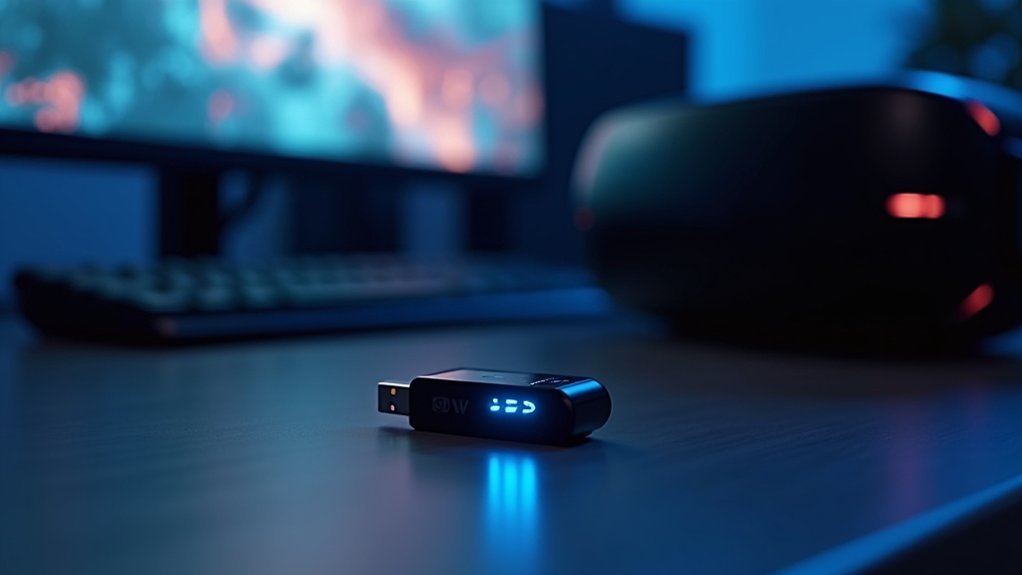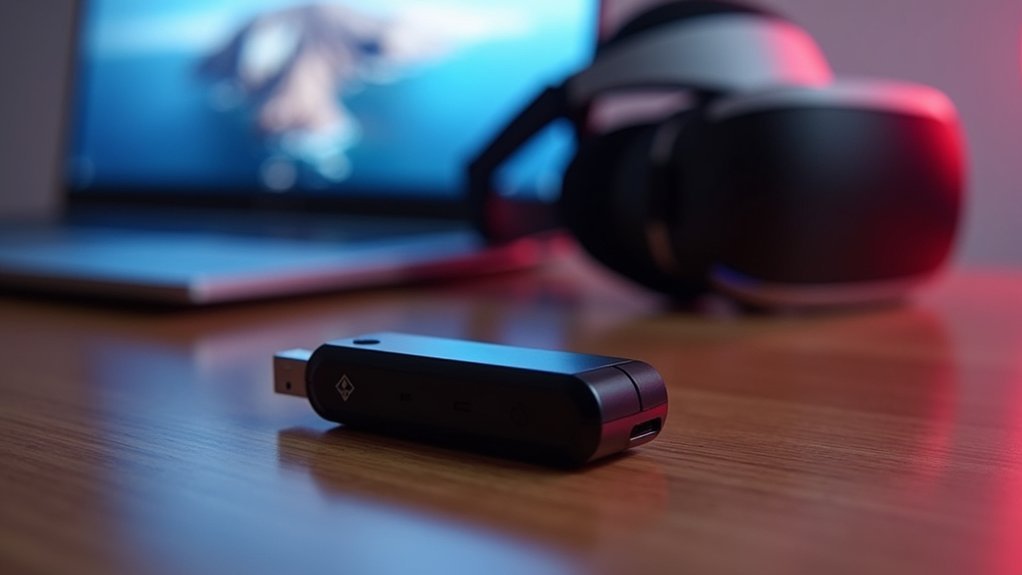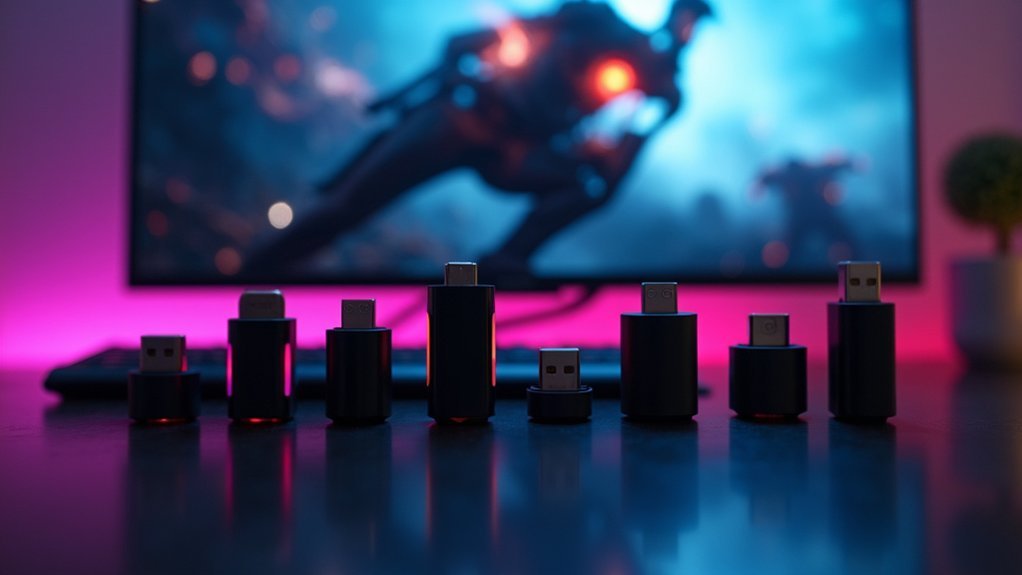You’ll want the Netgear Nighthawk A8000 for demanding VR with 619 Mbps Wi-Fi 6 speeds, or the ASUS ROG USB-BE92 offering up to 5.8 Gbps for future-proofing. Budget-conscious gamers can grab the MSI AX1800 at $45 for solid Wi-Fi 6 performance, while the TP-Link Archer T2U Plus works for basic setups at just $15. Wi-Fi 6E adapters like the TP-Link Archer TXE5400UH access the dedicated 6 GHz spectrum for interference-free gaming. Each adapter below offers specific advantages for different VR gaming scenarios and budgets.
Top-Rated USB Wi-Fi Adapters for Low-Latency VR Gaming

When you’re diving into VR gaming, your USB Wi-Fi adapter becomes the critical link between seamless immersion and frustrating lag spikes.
The Netgear Nighthawk A8000 leads the pack for low-latency VR gaming, delivering exceptional performance with speeds reaching 619 Mbps on Wi-Fi 6. This powerhouse handles demanding VR applications without breaking stride.
The MSI AX1800 offers solid wireless connectivity at $45, providing reliable performance for most VR setups.
While the TP-Link Archer T2U Plus won’t handle intensive VR gaming, it’s adequate for basic applications.
Proper antenna positioning dramatically impacts your gaming setup’s effectiveness. The Netgear Nighthawk includes extension cables and stands for ideal placement.
All these USB Wi-Fi adapters feature minimum one-year warranties, ensuring your investment stays protected while you explore virtual worlds.
Wi-Fi 6E Adapters That Deliver Superior VR Performance
Wi-Fi 6E adapters represent the next evolution in wireless gaming technology, unblocking the dedicated 6 GHz spectrum that transforms your VR experience.
These advanced network cards deliver tri-band capabilities that eliminate interference while providing speeds exceeding 1 Gbps for peak performance.
Models like the Netgear Nighthawk A8000 and ASUS ROG USB-BE92 integrate high-performance antennas that boost signal strength and coverage, ensuring seamless connectivity during intense VR gaming sessions.
You’ll benefit from Multi-Link Operation technology that utilizes multiple simultaneous connections, dramatically reducing latency.
With support for up to 9.6 Gbps throughput, Wi-Fi 6E adapters handle VR gaming’s demanding bandwidth requirements effortlessly.
Enhanced WPA3 security and improved frame rates create the smooth, lag-free experience essential for competitive gaming.
Budget-Friendly Wireless Solutions for Entry-Level VR Systems

Although premium adapters deliver cutting-edge performance, you don’t need to break the bank for quality VR gaming experiences. The TP-Link Archer T2U Plus stands out as an excellent budget-friendly option at $15, delivering 30 Mbps speeds at long range while streaming 4K videos seamlessly for entry-level VR systems.
For enhanced wireless connection quality, consider the MSI AX1800 WiFi USB Adapter at $45, offering robust Wi-Fi 6 performance that elevates your VR gaming sessions.
The BrosTrend 1200Mbps Long Range USB WiFi Adapter provides decent signal improvement despite build quality concerns, serving as a temporary solution. The TP-Link Archer T3U Plus features a rotatable antenna for optimized positioning.
If you’re willing to stretch your budget, the Netgear Nighthawk A8000 delivers exceptional high-speed performance for demanding applications.
High-Speed Adapters for Professional VR Development
Professional VR developers require wireless adapters that deliver uncompromising performance during intensive development workflows.
You’ll need high-speed solutions that won’t bottleneck your creative process when handling large assets and real-time testing.
The Netgear Nighthawk A8000 USB Wi-Fi adapter achieves impressive 619 Mbps speeds on Wi-Fi 6, providing sufficient throughput for demanding VR development tasks.
For enhanced performance, consider Wi-Fi 6E adapters like the TP-Link Archer TXE5400UH, which utilize the 6 GHz band for reduced interference and superior bandwidth.
However, PCIe network cards such as the Fenvi AX210 WiFi 6E often outperform USB alternatives for serious gaming and VR development applications.
They offer superior signal stability and lower latency, essential for professional workflows requiring consistent, reliable connectivity during intensive development sessions.
Compact USB Dongles Perfect for Portable VR Setups

Portable VR setups demand wireless adapters that won’t weigh down your gear or compromise performance when you’re gaming on the go.
The MSI AX1800 WiFi USB Adapter (GUAX18) delivers robust Wi-Fi 6 connectivity with excellent throughput, making it perfect for high-bandwidth VR gaming.
For ultra-compact solutions, the Asus USB-AX56 Nano combines dual-band support with minimal footprint, ensuring seamless wireless experiences without bulk.
The TP-Link Archer T3U Plus features a clever rotatable antenna design and AC1300 performance, providing reliable signal strength while maintaining portability.
These compact USB dongles eliminate the need for bulky adapters, letting you focus on immersive gaming experiences.
When choosing your portable wireless adapter, prioritize models that balance size constraints with the performance demands of modern VR applications.
Tri-Band Wireless Adapters for Multi-Device VR Environments
When you’re running multiple VR devices simultaneously, tri-band wireless adapters like the NETGEAR Nighthawk AXE3000 become essential for managing bandwidth across your entire setup.
You’ll benefit from dedicated band allocation that separates your VR traffic from other devices, while multi-device bandwidth management guarantees each headset gets the resources it needs.
These adapters also employ advanced latency reduction techniques that keep your VR experiences smooth and responsive, even when supporting gaming consoles and streaming devices concurrently.
Dedicated VR Band Allocation
As VR gaming environments become increasingly complex with multiple headsets and devices competing for bandwidth, tri-band wireless adapters offer a sophisticated solution by dedicating the 6 GHz band exclusively to VR traffic.
This dedicated approach guarantees your VR devices won’t compete with smartphones, tablets, or laptops using the 2.4 GHz and 5 GHz bands.
Best tri-band adapters like the ASUS ROG USB-BE92 create separate wireless highways for different device types.
You’ll experience superior performance when your VR headset has its own dedicated connection path, eliminating interference that causes lag and stuttering.
High-performance models such as the TP-Link Archer TBE3600U deliver speeds up to 3.6 Gbps, providing the bandwidth necessary for seamless gaming across multiple VR devices simultaneously.
Multi-Device Bandwidth Management
While dedicated band allocation creates isolated channels for VR traffic, effective bandwidth management becomes critical when you’re running multiple VR headsets, base stations, and wireless accessories simultaneously.
Tri-band adapters excel at distributing traffic across three distinct frequencies, preventing congestion that’d typically bottleneck your VR gaming sessions.
Multi-Link Operation technology enables these adapters to intelligently route data streams, ensuring each device maintains peak performance.
Here’s how tri-band adapters transform multi-device environments:
- Smart frequency allocation – Automatically assigns devices to less congested bands
- Enhanced antenna systems – Beamforming technology strengthens signal strength to individual devices
- Real-time traffic management – Prioritizes bandwidth for demanding applications
This sophisticated bandwidth management translates to smoother gaming experiences across multiple devices, eliminating the lag and stuttering that’d otherwise plague multi-user VR setups.
Latency Reduction Techniques
Though traditional dual-band adapters struggle with latency spikes in crowded VR environments, tri-band wireless adapters like the NETGEAR Nighthawk AXE3000 eliminate these bottlenecks through dedicated 6 GHz channels.
You’ll experience dramatically reduced congestion when multiple devices compete for bandwidth simultaneously. These adapters leverage MU-MIMO and OFDMA technologies to transmit data to several devices at once, stabilizing your Wi-Fi connection during intense gaming sessions.
You can expect latency improvements of 30-40 milliseconds compared to dual-band alternatives in high-traffic scenarios. The dedicated bandwidth allocation supports VR gaming’s demanding 3 Gbps requirements without interruptions.
Enhanced signal coverage through multiple high-performance antennas guarantees consistent performance across larger spaces, maintaining peak connection quality even when physical obstructions interfere with traditional adapters’ signals.
Future-Proof Wi-Fi 7 Adapters for Next-Generation VR Headsets
You’ll need Wi-Fi 7 adapters to handle next-generation VR headsets that demand unprecedented bandwidth and ultra-low latency for seamless immersion.
These cutting-edge adapters tackle VR’s stringent requirements by minimizing motion-to-photon delay through Multi-Link Operation technology, ensuring your movements translate instantly to visual feedback.
Understanding your specific bandwidth needs becomes vital as VR applications push data throughput beyond what current wireless standards can reliably deliver.
VR Latency Optimization
Most VR gamers don’t realize that network latency can make or break their immersive experience, but Wi-Fi 7 adapters are changing the game entirely.
These cutting-edge devices eliminate data transmission delays that plague traditional wireless connections, delivering the instantaneous feedback your VR applications demand.
Here’s how Wi-Fi 7 adapters optimize your untethered gaming setup:
- Dedicated bandwidth: The ASUS ROG USB-BE92’s tri-band connectivity provides exclusive 6 GHz channels, reducing latency considerably.
- Enhanced stability: Multi-Link Operation in the TP-Link Archer TBE3600U connects to multiple routers simultaneously for consistent performance.
- Secure speed: Advanced WPA3 security maintains fast, protected connections without compromising responsiveness.
With speeds reaching 5.8 Gbps, these adapters guarantee your VR headset receives data instantaneously, creating truly immersive experiences.
Bandwidth Requirements Analysis
While current VR headsets typically consume 1-3 Gbps of bandwidth, next-generation models will demand upwards of 5 Gbps to deliver the ultra-high resolution displays and real-time processing that define tomorrow’s immersive experiences.
You’ll need a Wi-Fi 7 adapter like the ASUS ROG USB-BE92 to meet these requirements, offering maximum speed up to 5.8 Gbps.
When you connect to a Wi-Fi 7 network, you’ll benefit from Multi-Link Operation technology that utilizes multiple channels simultaneously for enhanced performance.
The dedicated 6 GHz band reduces interference from other devices, guaranteeing consistent high-speed connectivity during online gaming sessions.
This future-proof technology guarantees your VR headsets won’t be bottlenecked by inadequate bandwidth as applications become increasingly demanding.
Frequently Asked Questions
Are Wireless Adapters Good for Gaming?
You’ll find wireless adapters aren’t ideal for gaming due to higher latency and interference issues. You’re better off using wired Ethernet, PCIe Wi-Fi cards, or Powerline adapters for stable, responsive gaming performance instead.
What Is the Difference Between a Wifi Adapter and a Wi-Fi Dongle?
A Wi-Fi adapter’s a general term for any wireless connectivity device, while you’ll find a Wi-Fi dongle’s specifically a compact USB device that plugs directly into your computer for instant wireless access.
How Many Mbps Wifi Adapter Do I Need for Gaming?
You’ll need at least 100 Mbps for smooth gaming, but consider getting an AC1200 adapter (1.2 Gbps) for better performance. Serious gamers should opt for AC1900 or Wi-Fi 6 adapters.
Is a 300 Mbps Wifi Adapter Good for Gaming?
A 300 Mbps adapter’s adequate for casual gaming since games need only 3-6 Mbps. However, you’ll face latency issues in competitive gaming and struggle with simultaneous 4K streaming or large downloads.
In Summary
You’ve got plenty of excellent options to cut the cord and immerse yourself in wireless VR gaming. Whether you’re working with a tight budget or need professional-grade performance, there’s an adapter that’ll meet your needs. Don’t forget to take into account your specific setup requirements and future upgrading plans. With these wireless solutions, you’ll experience the freedom of untethered gaming without sacrificing the smooth, responsive performance that makes VR truly immersive.





Leave a Reply